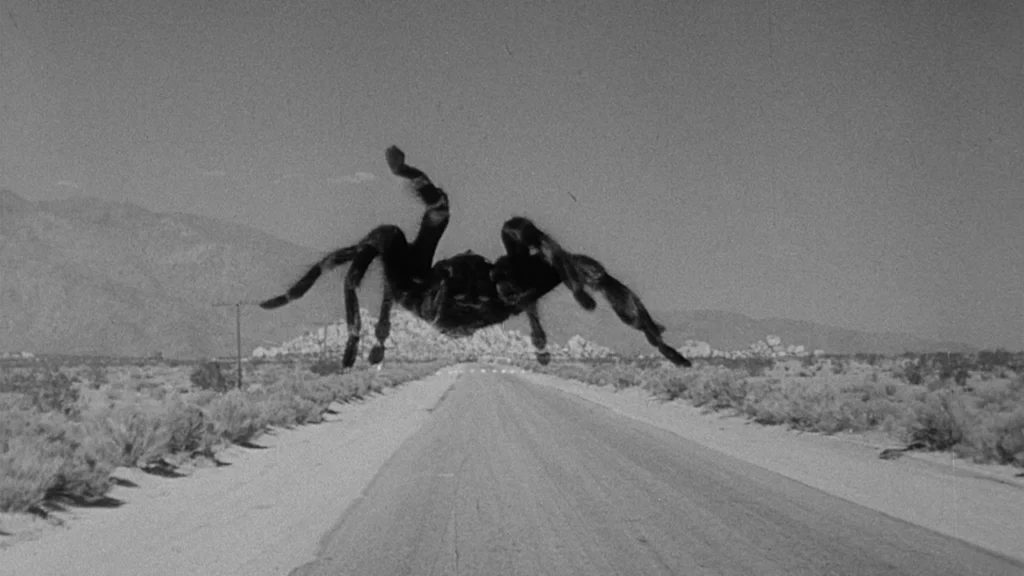The 1950s were a decade defined by fears of nuclear war, outdated gender norms, and conservative values that overtook the general population, creating a country of ultra-patriotic bigots. Thank God this country isn’t like that anymore. Right? Jokes and politics only somewhat aside, the current, very real fear of nuclear warfare was, of course, ever more present in the 1950s. This is what created the “Atomic Age” of horror. Fear of nuclear radiation led to filmmakers producing a plethora of “giant” everything movies. Giant wasps (Monster from Green Hell), giant ants (Them), and even giant lizards (The Giant Gila Monster).
Tarantula (1955): The Ultimate Atomic Age Giant Spider Classic
In Japan, monster movies took a slightly different approach, with the original Godzilla being a slow-paced drama and existentially terrifying metaphor for Hiroshima. American versions of this were much cheesier, but still had a similar terror. And they absolutely ruled the silver screen. However, one mammoth bug from Universal Pictures towers above them all. Tarantula from 1955, from It Came from Outer Space director Jack Arnold, is one of the greatest giant spider movies of all time, and definitely a cult classic that has earned its spot as one of the finest atomic age monster flicks.
The story follows Dr. Matt Hastings (John Agar) and Scientist Stephanie Clayton (Mara Cordray) attempting to understand and help stop a gigantic, mutated Tarantula from wreaking havoc on a small Arizona town. The creature stems from genetic and nuclear testing, having escaped from a desolate desert lab.
Not only is it a creepy, enthralling, suspenseful, and charm-filled novelty of its time, but it also carries the weight of existential dread hiding under the surface of the era.
Why Tarantula Stands Out Among Atomic Age Monster Flicks
Spiders are eternal creatures of discomfort in horror. From realistic creepy crawlies like Arachnophobia (1990) to giants in kitschy flicks like Eight Legged Freaks (2002), all the way back to Arachnida the human spider in The Show (1927), these arachnids have been causing nightmares since the birth of cinema. Still, the idea of a giant tarantula flick, especially one from the 50s’, probably does not ring true as particularly scary.
Maybe cheesy? Campy? Even laughably bad? While yes, Tarantula is as much of a cheese-fest as it sounds, the spider is genuinely eerie. At the very least, it is one of the scariest of this era.
Firstly, the spider is not a cheap rubber prop, but an actual, edited in tarantula. Maybe still campy, but definitely creepier. The dated nature of the effects give the monster an eerie, ominous present, appearing almost like this foreboding dark shadow of death and destruction. The Arizona desert setting also lets the film seep into an almost surrealist, Lynchian quality. Seriously, it is genuinely one of the scarier entries from this period, truly standing the test of time.
The pure emptiness, overtaken by its overcast shadow of nightmarish dread, is genuinely chilling and helps it stand out amongst the rest of these types of movies. An artistic effort was made, which makes for sci-fi suspense that still adds up.
How 1950s Duck-and-Cover Drills Fueled Existential Horror
In 2025, kids in schools regularly practice bomb and school shooting drills, living in a modern state of fear. Times change, but mass fear is embedded in a country with so many skeletons in the closet. In the 1950s, kids from elementary school onward prepped for a nuclear apocalypse. Everyone is familiar with the morbidly funny Duck-And-Cover PSAs, and shows like Fallout continue to foster these atomic-aged aesthetics. Although they went about it with a sense of cheery Suburban optimism, it was an underlying existential horror to constantly be wary of nuclear apocalypse.
Post World War 2, with the H-Bomb developed and the Cold War with Soviet Russia rising, filmmakers began to process these fears with something more whimsical. This, of course, is where these atomic-age bugs come in.
Tarantula’s Giant Spider: A Metaphor for Cold War Nuclear Terror
Tarantula is one of many movies featuring giant insects. While not exposed to traditional nuclear radiation, this massive spider is the product of unexplored scientific testing involving radioactive isotopes, feeding into that fear.
Cheesy as they are, these movies illicit a greater metaphoric terror. The gargantuan nature of these insects symbolizes how small Americans felt. During the Cold War, there was only so much people could do to prepare for what would undoubtedly be the end of the World. Unlike the Godzilla film of Japan, the monsters were not battled with other beasts or allied monsters in these movies. It is many ant-sized humans up against one greater threat.
These were drive-in, blockbuster flicks, almost like MCU films of their days. Still, the horror is rooted in something more profound and human.
Tarantula is a clearcut symbol of nuclear terror, and the feeling of being small when faced up against an existential threat. And these films should be reflected on now more than ever. With the world in political turmoil, and fear of nuclear war ever present, processing these fears through the guise of a giant spider movie may be the perfect way to relieve tension in troubling times.
